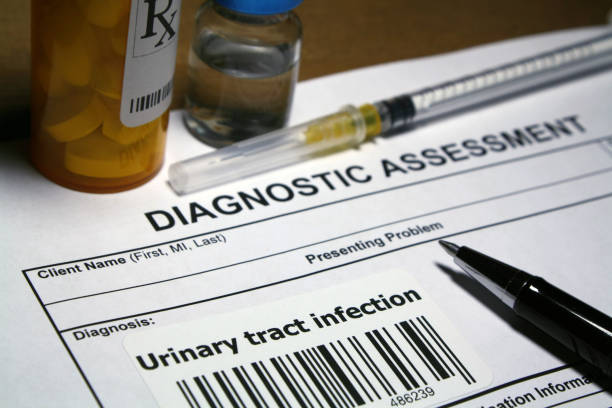Health Conditions
Discover the Truth about UTI Pain
Understanding the sensation of urinary tract infection (UTI) pain is crucial for the timely recognition and management of this common ailment. UTIs occur when bacteria enter the urinary tract and multiply, leading to inflammation and discomfort. However, describing UTI pain can be subjective and vary among individuals. For some, it may manifest as a constant, dull ache in the lower abdomen, while others may experience a sharp, burning sensation during urination. Additionally, UTI pain may extend to the back or sides and intensify as the infection progresses. Recognizing the distinct characteristics of UTI pain can help individuals seek appropriate medical attention and initiate prompt treatment. In this article, we delve into the nuances of UTI pain, exploring its common symptoms, associated discomfort, and strategies for relief, empowering readers to better identify and manage this prevalent urinary condition.

Understanding UTIs
Urinary tract infections (UTIs) are common bacterial infections of the urinary system. The urinary system consists of the kidneys, ureters, bladder, and urethra. The kidneys remove waste from the blood and generate urine, which flows down the ureters to the bladder. Urine is held in the bladder and released through the urethra during urination.
Anatomy of the Urinary System
The urethra is the tube that transports pee from the bladder to outside the body. Women have a shorter urethra than men, making it easier for bacteria to enter the bladder and create an infection. In men, the prostate gland surrounds the urethra and can get infected, resulting in UTIs.
Common Causes of UTIs
UTIs are caused by bacteria that enter the urinary system via the urethra and grow in the bladder. The most frequent bacteria that causes UTIs is Escherichia coli (E. coli), which is generally found in the stomach tract. Sexual activity can significantly raise the risk of UTIs since germs can enter the urinary system during intercourse.
Risk Factors for UTIs
Women are more likely to have UTIs than men because their urethra is shorter and closer to the anus, making it easier for bacteria to enter the bladder. Other risk factors for urinary tract infections include catheter use, diabetes, menopause, pregnancy, and a weakened immune system. Older folks are also more likely to develop UTIs because they may struggle to completely empty their bladder.

Symptoms and Signs
UTI discomfort can be both severe and debilitating. Identifying signs early on can help prevent the infection from spreading to the kidneys and creating more serious symptoms.
Identifying UTI Symptoms
Symptoms of a UTI vary depending on the severity of the infection and which portion of the urinary system is involved. Common symptoms include a burning sensation while urinating, a frequent urge to urinate, and passing small volumes of urine at once. Other symptoms may include strong-smelling urine, pelvic pain, and a sensation of pressure in the lower abdomen.
Pain Characteristics
UTI pain is commonly described as a burning or stinging sensation while urinating. Pain may be accompanied by a sensation of pressure or discomfort in the lower abdomen. In certain situations, the discomfort can spread to the back or sides, indicating a kidney infection.
Additional Symptoms
In addition to pain and discomfort, a UTI can induce fever, nausea, chills, vomiting, and confusion. These symptoms may signal a more serious infection necessitating quick medical intervention.
It is crucial to understand that not all UTIs cause symptoms. In rare situations, a person can have a UTI without feeling any pain or discomfort. However, even asymptomatic UTIs can have serious problems if not addressed.
Overall, if a person feels they have a UTI, they should seek medical assistance immediately to avoid the infection from spreading and creating more serious symptoms.

Diagnosis and Treatment
Professional Diagnosis
If someone suspects that they have a UTI, they should seek medical attention. The healthcare practitioner may inquire about the patient’s symptoms, and medical history, and conduct a physical examination. They may also request a urine test, which could be a urine dipstick, urinalysis, or urine culture. These tests can help detect whether an illness exists and which type of bacteria is causing it.
Treatment Options
If a UTI is identified, your healthcare provider may prescribe medications to treat the infection. It is critical to complete the entire course of antibiotics as prescribed, even if symptoms improve before the medicine is done. Failure to complete the entire course of antibiotics can result in the development of antibiotic-resistant bacteria, which are more difficult to treat.
In addition to antibiotics, the healthcare professional may prescribe over-the-counter pain medications to alleviate symptoms including pain and discomfort. It is critical to discuss any medication use with a healthcare expert to ensure its safety and efficacy.
When to See a Doctor
It is critical to seek medical assistance if UTI symptoms persist or worsen despite therapy, or if new symptoms appear. Untreated UTIs can lead to renal damage and sepsis, both of which are potentially fatal. If someone develops symptoms such as fever, chills, nausea, vomiting, or severe pain, they should seek medical assistance right once.
In some circumstances, a professional may be required to help manage the UTI. This could include a urologist or an infectious disease specialist. The healthcare professional can assist in determining the need for a specialist and, if necessary, offer a referral.
Overall, quick and appropriate treatment of UTIs is critical to avoiding complications and ensuring complete recovery.

Prevention and Management
Lifestyle and Home Remedies.
There are various steps that can be taken to prevent or treat reoccurring UTIs in the home. One of the most crucial steps is to drink enough water all day. This helps to flush the urinary tract and keeps bacteria from collecting in the bladder.
Another vital step is to practice proper personal hygiene. This involves wiping from front to back after using the restroom, which helps to keep bacteria from the anal region from entering the urethra. Women should avoid using douches or powders in the vaginal area since they can irritate the urethra and increase the risk of infection.
Cranberry juice has long been believed to help prevent UTIs, although the data is conflicting. Some studies suggest that cranberry juice can help prevent bacteria from sticking to the bladder wall, while others show no meaningful effect. Nonetheless, cranberry juice is unlikely to be harmful and may be worth a try for those who are prone to UTIs.
Medical Prevention Strategies
For patients who have recurring UTIs, medical preventative strategies may be required. One option is to take a low-dose antibiotic every day, which can help prevent bacteria from collecting in the urinary system. Another alternative is to utilize a contraceptive method that does not raise the risk of UTIs, such as a copper intrauterine device.
It is also critical to engage in safe sex, as sexual activity might raise the risk of UTI. Urinating before and after sexual activity, as well as using a condom, can help lower the chance of infection. Finally, persons who have recurring UTIs should consult with their healthcare physician about additional preventative and management options.
Conclusion
In conclusion, understanding the sensations associated with urinary tract infection (UTI) pain is critical for early detection and efficient treatment of this common ailment. While the strength and presentation of UTI pain varies by individual, frequent symptoms include a dull aching in the lower abdomen, a burning feeling during urination, and discomfort radiating to the back or sides. Recognizing these distinguishing traits allows individuals to seek immediate medical evaluation and begin appropriate treatment to reduce symptoms and prevent consequences. Furthermore, staying hydrated, practicing basic hygiene, and getting medical assistance at the first sign of symptoms will help reduce the duration and intensity of UTI pain. We can improve people’s quality of life and urinary tract health by increasing understanding of the various forms of UTI discomfort and empowering them to take proactive steps for symptom management.
Trusted Health, Wellness, and Medical advice for your well-being


